Leadership and Change: Cultural Challenges in Mergers & Acquisitions
VerifiedAdded on 2023/01/12
|13
|3763
|41
Report
AI Summary
This report critically evaluates the statement that most mergers and acquisitions fail to achieve their objectives due to cultural differences. It explores the reasons behind M&A failures, emphasizing the significance of cultural integration and effective leadership. The report discusses various academic models, such as Edgar Schein's model of organizational culture and McKinsey's 7S framework, to manage cultural differences. It also highlights the importance of PESTLE analysis in evaluating the feasibility of entering new markets. Furthermore, the report suggests using transformational leadership and change management models like Kurt Lewin's or Kotter's to effectively manage the changes during mergers and acquisitions, recommending that companies focus on clear communication, goal alignment, and understanding resistance to cultural change to improve the success rate of these ventures. Desklib offers similar solved assignments and past papers for students.
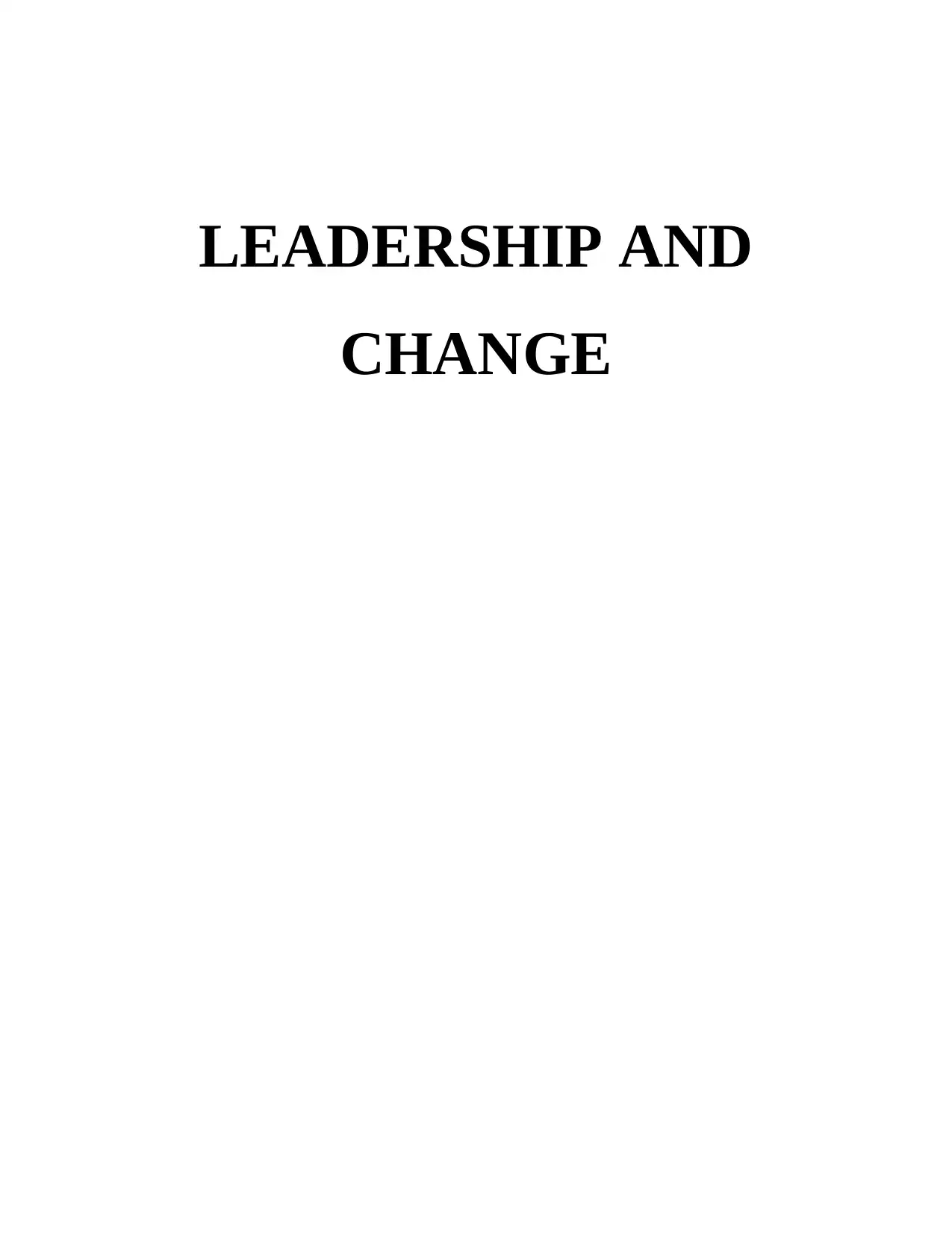
LEADERSHIP AND
CHANGE
CHANGE
Paraphrase This Document
Need a fresh take? Get an instant paraphrase of this document with our AI Paraphraser
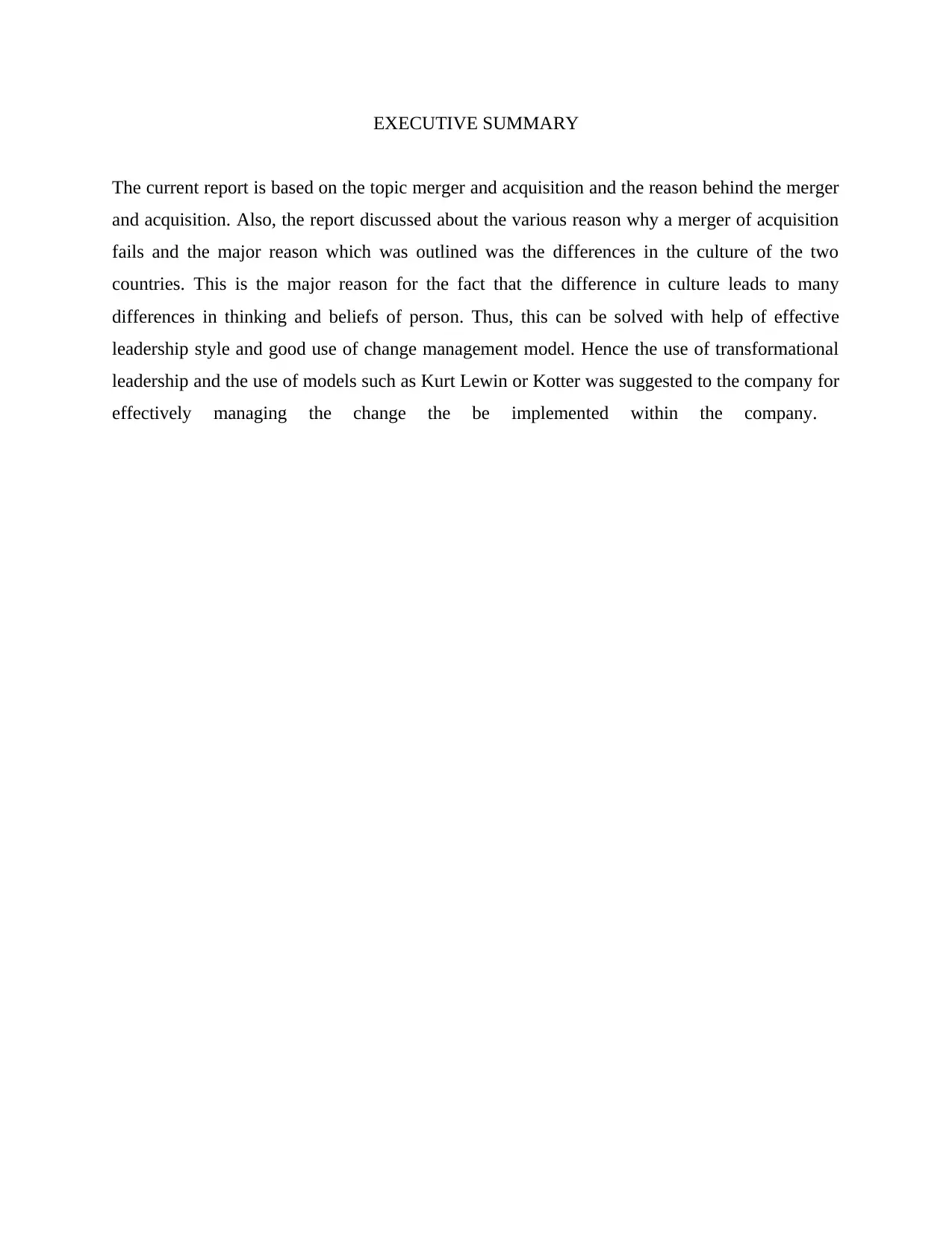
EXECUTIVE SUMMARY
The current report is based on the topic merger and acquisition and the reason behind the merger
and acquisition. Also, the report discussed about the various reason why a merger of acquisition
fails and the major reason which was outlined was the differences in the culture of the two
countries. This is the major reason for the fact that the difference in culture leads to many
differences in thinking and beliefs of person. Thus, this can be solved with help of effective
leadership style and good use of change management model. Hence the use of transformational
leadership and the use of models such as Kurt Lewin or Kotter was suggested to the company for
effectively managing the change the be implemented within the company.
The current report is based on the topic merger and acquisition and the reason behind the merger
and acquisition. Also, the report discussed about the various reason why a merger of acquisition
fails and the major reason which was outlined was the differences in the culture of the two
countries. This is the major reason for the fact that the difference in culture leads to many
differences in thinking and beliefs of person. Thus, this can be solved with help of effective
leadership style and good use of change management model. Hence the use of transformational
leadership and the use of models such as Kurt Lewin or Kotter was suggested to the company for
effectively managing the change the be implemented within the company.
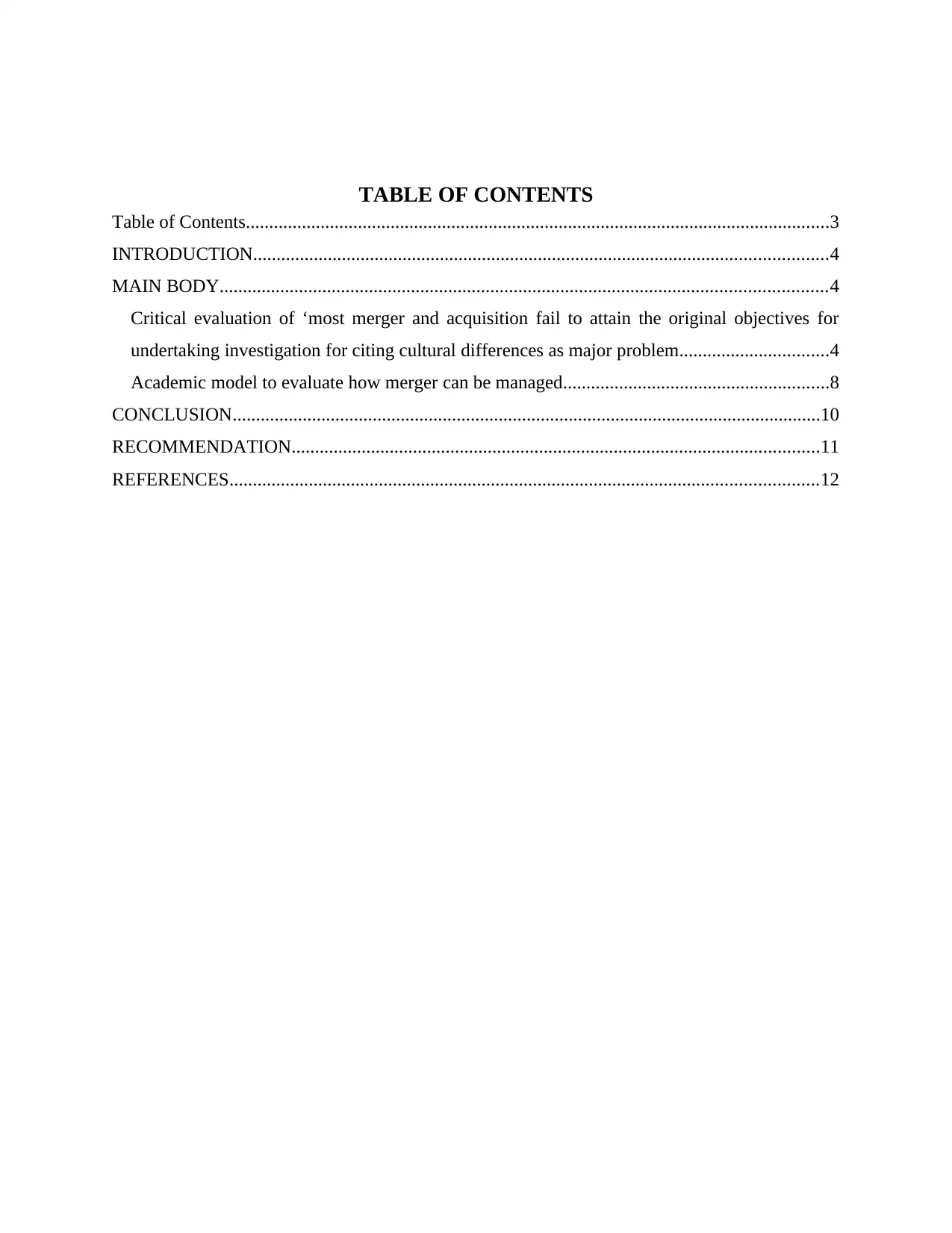
TABLE OF CONTENTS
Table of Contents.............................................................................................................................3
INTRODUCTION...........................................................................................................................4
MAIN BODY..................................................................................................................................4
Critical evaluation of ‘most merger and acquisition fail to attain the original objectives for
undertaking investigation for citing cultural differences as major problem................................4
Academic model to evaluate how merger can be managed.........................................................8
CONCLUSION..............................................................................................................................10
RECOMMENDATION.................................................................................................................11
REFERENCES..............................................................................................................................12
Table of Contents.............................................................................................................................3
INTRODUCTION...........................................................................................................................4
MAIN BODY..................................................................................................................................4
Critical evaluation of ‘most merger and acquisition fail to attain the original objectives for
undertaking investigation for citing cultural differences as major problem................................4
Academic model to evaluate how merger can be managed.........................................................8
CONCLUSION..............................................................................................................................10
RECOMMENDATION.................................................................................................................11
REFERENCES..............................................................................................................................12
⊘ This is a preview!⊘
Do you want full access?
Subscribe today to unlock all pages.

Trusted by 1+ million students worldwide
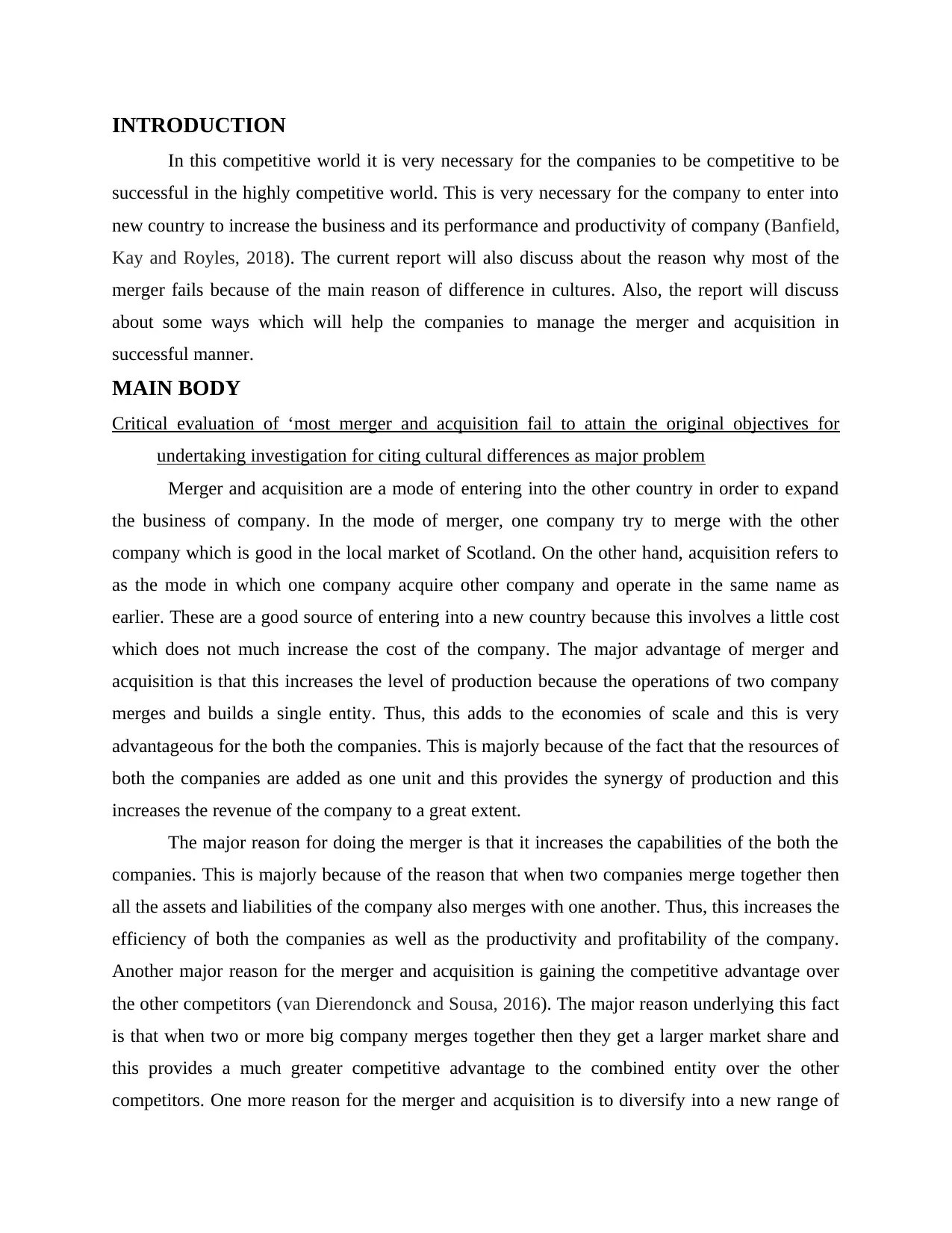
INTRODUCTION
In this competitive world it is very necessary for the companies to be competitive to be
successful in the highly competitive world. This is very necessary for the company to enter into
new country to increase the business and its performance and productivity of company (Banfield,
Kay and Royles, 2018). The current report will also discuss about the reason why most of the
merger fails because of the main reason of difference in cultures. Also, the report will discuss
about some ways which will help the companies to manage the merger and acquisition in
successful manner.
MAIN BODY
Critical evaluation of ‘most merger and acquisition fail to attain the original objectives for
undertaking investigation for citing cultural differences as major problem
Merger and acquisition are a mode of entering into the other country in order to expand
the business of company. In the mode of merger, one company try to merge with the other
company which is good in the local market of Scotland. On the other hand, acquisition refers to
as the mode in which one company acquire other company and operate in the same name as
earlier. These are a good source of entering into a new country because this involves a little cost
which does not much increase the cost of the company. The major advantage of merger and
acquisition is that this increases the level of production because the operations of two company
merges and builds a single entity. Thus, this adds to the economies of scale and this is very
advantageous for the both the companies. This is majorly because of the fact that the resources of
both the companies are added as one unit and this provides the synergy of production and this
increases the revenue of the company to a great extent.
The major reason for doing the merger is that it increases the capabilities of the both the
companies. This is majorly because of the reason that when two companies merge together then
all the assets and liabilities of the company also merges with one another. Thus, this increases the
efficiency of both the companies as well as the productivity and profitability of the company.
Another major reason for the merger and acquisition is gaining the competitive advantage over
the other competitors (van Dierendonck and Sousa, 2016). The major reason underlying this fact
is that when two or more big company merges together then they get a larger market share and
this provides a much greater competitive advantage to the combined entity over the other
competitors. One more reason for the merger and acquisition is to diversify into a new range of
In this competitive world it is very necessary for the companies to be competitive to be
successful in the highly competitive world. This is very necessary for the company to enter into
new country to increase the business and its performance and productivity of company (Banfield,
Kay and Royles, 2018). The current report will also discuss about the reason why most of the
merger fails because of the main reason of difference in cultures. Also, the report will discuss
about some ways which will help the companies to manage the merger and acquisition in
successful manner.
MAIN BODY
Critical evaluation of ‘most merger and acquisition fail to attain the original objectives for
undertaking investigation for citing cultural differences as major problem
Merger and acquisition are a mode of entering into the other country in order to expand
the business of company. In the mode of merger, one company try to merge with the other
company which is good in the local market of Scotland. On the other hand, acquisition refers to
as the mode in which one company acquire other company and operate in the same name as
earlier. These are a good source of entering into a new country because this involves a little cost
which does not much increase the cost of the company. The major advantage of merger and
acquisition is that this increases the level of production because the operations of two company
merges and builds a single entity. Thus, this adds to the economies of scale and this is very
advantageous for the both the companies. This is majorly because of the fact that the resources of
both the companies are added as one unit and this provides the synergy of production and this
increases the revenue of the company to a great extent.
The major reason for doing the merger is that it increases the capabilities of the both the
companies. This is majorly because of the reason that when two companies merge together then
all the assets and liabilities of the company also merges with one another. Thus, this increases the
efficiency of both the companies as well as the productivity and profitability of the company.
Another major reason for the merger and acquisition is gaining the competitive advantage over
the other competitors (van Dierendonck and Sousa, 2016). The major reason underlying this fact
is that when two or more big company merges together then they get a larger market share and
this provides a much greater competitive advantage to the combined entity over the other
competitors. One more reason for the merger and acquisition is to diversify into a new range of
Paraphrase This Document
Need a fresh take? Get an instant paraphrase of this document with our AI Paraphraser
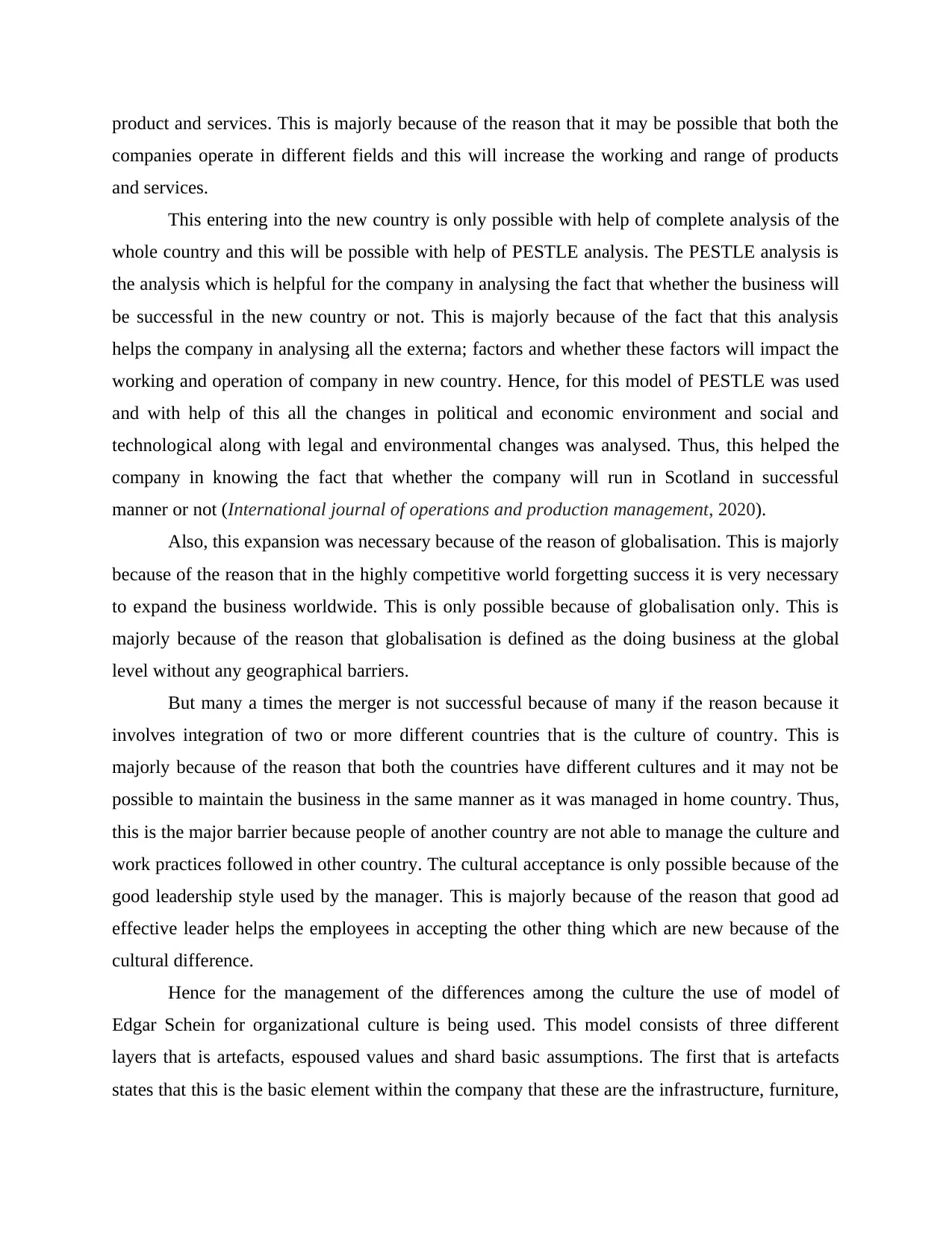
product and services. This is majorly because of the reason that it may be possible that both the
companies operate in different fields and this will increase the working and range of products
and services.
This entering into the new country is only possible with help of complete analysis of the
whole country and this will be possible with help of PESTLE analysis. The PESTLE analysis is
the analysis which is helpful for the company in analysing the fact that whether the business will
be successful in the new country or not. This is majorly because of the fact that this analysis
helps the company in analysing all the externa; factors and whether these factors will impact the
working and operation of company in new country. Hence, for this model of PESTLE was used
and with help of this all the changes in political and economic environment and social and
technological along with legal and environmental changes was analysed. Thus, this helped the
company in knowing the fact that whether the company will run in Scotland in successful
manner or not (International journal of operations and production management, 2020).
Also, this expansion was necessary because of the reason of globalisation. This is majorly
because of the reason that in the highly competitive world forgetting success it is very necessary
to expand the business worldwide. This is only possible because of globalisation only. This is
majorly because of the reason that globalisation is defined as the doing business at the global
level without any geographical barriers.
But many a times the merger is not successful because of many if the reason because it
involves integration of two or more different countries that is the culture of country. This is
majorly because of the reason that both the countries have different cultures and it may not be
possible to maintain the business in the same manner as it was managed in home country. Thus,
this is the major barrier because people of another country are not able to manage the culture and
work practices followed in other country. The cultural acceptance is only possible because of the
good leadership style used by the manager. This is majorly because of the reason that good ad
effective leader helps the employees in accepting the other thing which are new because of the
cultural difference.
Hence for the management of the differences among the culture the use of model of
Edgar Schein for organizational culture is being used. This model consists of three different
layers that is artefacts, espoused values and shard basic assumptions. The first that is artefacts
states that this is the basic element within the company that these are the infrastructure, furniture,
companies operate in different fields and this will increase the working and range of products
and services.
This entering into the new country is only possible with help of complete analysis of the
whole country and this will be possible with help of PESTLE analysis. The PESTLE analysis is
the analysis which is helpful for the company in analysing the fact that whether the business will
be successful in the new country or not. This is majorly because of the fact that this analysis
helps the company in analysing all the externa; factors and whether these factors will impact the
working and operation of company in new country. Hence, for this model of PESTLE was used
and with help of this all the changes in political and economic environment and social and
technological along with legal and environmental changes was analysed. Thus, this helped the
company in knowing the fact that whether the company will run in Scotland in successful
manner or not (International journal of operations and production management, 2020).
Also, this expansion was necessary because of the reason of globalisation. This is majorly
because of the reason that in the highly competitive world forgetting success it is very necessary
to expand the business worldwide. This is only possible because of globalisation only. This is
majorly because of the reason that globalisation is defined as the doing business at the global
level without any geographical barriers.
But many a times the merger is not successful because of many if the reason because it
involves integration of two or more different countries that is the culture of country. This is
majorly because of the reason that both the countries have different cultures and it may not be
possible to maintain the business in the same manner as it was managed in home country. Thus,
this is the major barrier because people of another country are not able to manage the culture and
work practices followed in other country. The cultural acceptance is only possible because of the
good leadership style used by the manager. This is majorly because of the reason that good ad
effective leader helps the employees in accepting the other thing which are new because of the
cultural difference.
Hence for the management of the differences among the culture the use of model of
Edgar Schein for organizational culture is being used. This model consists of three different
layers that is artefacts, espoused values and shard basic assumptions. The first that is artefacts
states that this is the basic element within the company that these are the infrastructure, furniture,
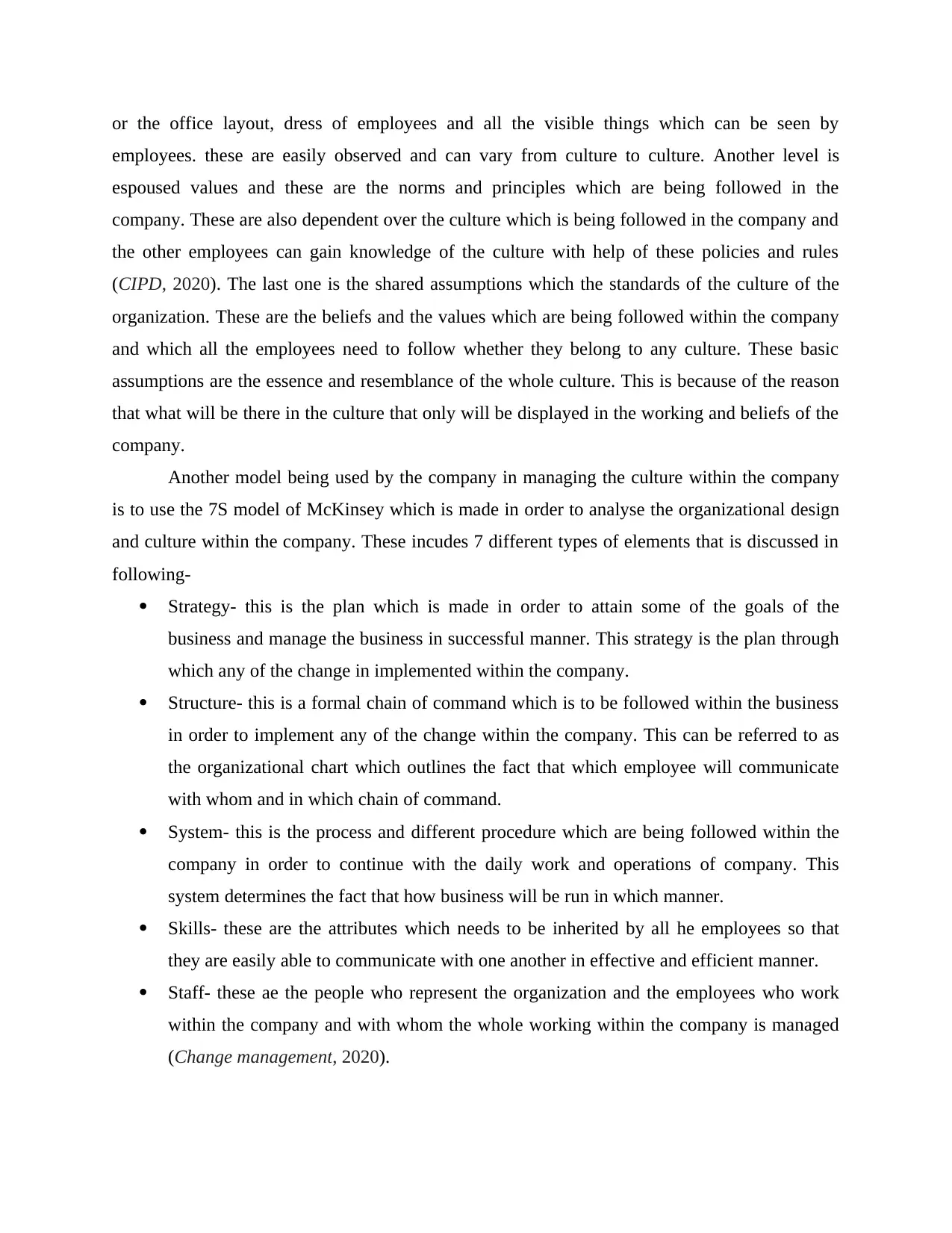
or the office layout, dress of employees and all the visible things which can be seen by
employees. these are easily observed and can vary from culture to culture. Another level is
espoused values and these are the norms and principles which are being followed in the
company. These are also dependent over the culture which is being followed in the company and
the other employees can gain knowledge of the culture with help of these policies and rules
(CIPD, 2020). The last one is the shared assumptions which the standards of the culture of the
organization. These are the beliefs and the values which are being followed within the company
and which all the employees need to follow whether they belong to any culture. These basic
assumptions are the essence and resemblance of the whole culture. This is because of the reason
that what will be there in the culture that only will be displayed in the working and beliefs of the
company.
Another model being used by the company in managing the culture within the company
is to use the 7S model of McKinsey which is made in order to analyse the organizational design
and culture within the company. These incudes 7 different types of elements that is discussed in
following-
Strategy- this is the plan which is made in order to attain some of the goals of the
business and manage the business in successful manner. This strategy is the plan through
which any of the change in implemented within the company.
Structure- this is a formal chain of command which is to be followed within the business
in order to implement any of the change within the company. This can be referred to as
the organizational chart which outlines the fact that which employee will communicate
with whom and in which chain of command.
System- this is the process and different procedure which are being followed within the
company in order to continue with the daily work and operations of company. This
system determines the fact that how business will be run in which manner.
Skills- these are the attributes which needs to be inherited by all he employees so that
they are easily able to communicate with one another in effective and efficient manner.
Staff- these ae the people who represent the organization and the employees who work
within the company and with whom the whole working within the company is managed
(Change management, 2020).
employees. these are easily observed and can vary from culture to culture. Another level is
espoused values and these are the norms and principles which are being followed in the
company. These are also dependent over the culture which is being followed in the company and
the other employees can gain knowledge of the culture with help of these policies and rules
(CIPD, 2020). The last one is the shared assumptions which the standards of the culture of the
organization. These are the beliefs and the values which are being followed within the company
and which all the employees need to follow whether they belong to any culture. These basic
assumptions are the essence and resemblance of the whole culture. This is because of the reason
that what will be there in the culture that only will be displayed in the working and beliefs of the
company.
Another model being used by the company in managing the culture within the company
is to use the 7S model of McKinsey which is made in order to analyse the organizational design
and culture within the company. These incudes 7 different types of elements that is discussed in
following-
Strategy- this is the plan which is made in order to attain some of the goals of the
business and manage the business in successful manner. This strategy is the plan through
which any of the change in implemented within the company.
Structure- this is a formal chain of command which is to be followed within the business
in order to implement any of the change within the company. This can be referred to as
the organizational chart which outlines the fact that which employee will communicate
with whom and in which chain of command.
System- this is the process and different procedure which are being followed within the
company in order to continue with the daily work and operations of company. This
system determines the fact that how business will be run in which manner.
Skills- these are the attributes which needs to be inherited by all he employees so that
they are easily able to communicate with one another in effective and efficient manner.
Staff- these ae the people who represent the organization and the employees who work
within the company and with whom the whole working within the company is managed
(Change management, 2020).
⊘ This is a preview!⊘
Do you want full access?
Subscribe today to unlock all pages.

Trusted by 1+ million students worldwide
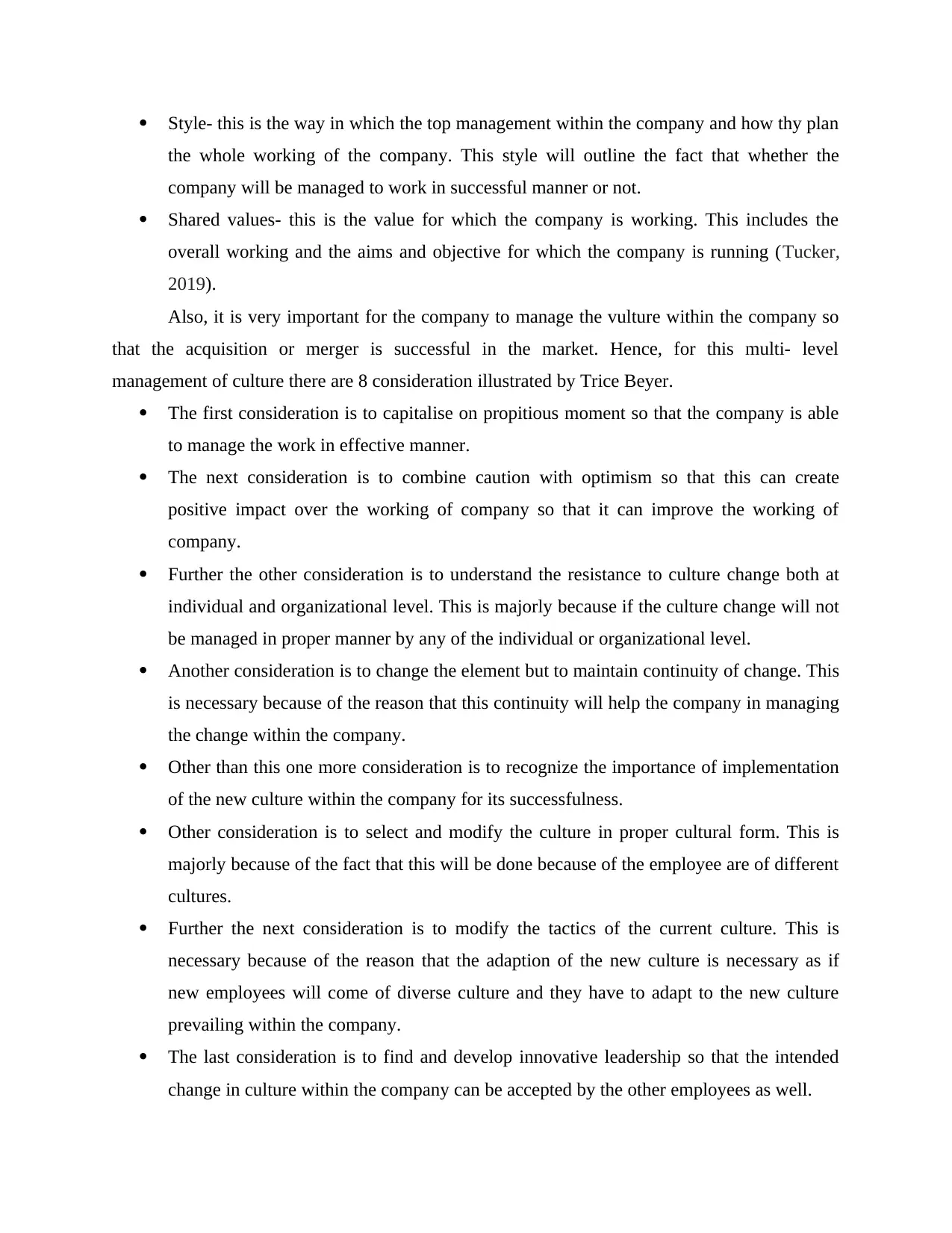
Style- this is the way in which the top management within the company and how thy plan
the whole working of the company. This style will outline the fact that whether the
company will be managed to work in successful manner or not.
Shared values- this is the value for which the company is working. This includes the
overall working and the aims and objective for which the company is running (Tucker,
2019).
Also, it is very important for the company to manage the vulture within the company so
that the acquisition or merger is successful in the market. Hence, for this multi- level
management of culture there are 8 consideration illustrated by Trice Beyer.
The first consideration is to capitalise on propitious moment so that the company is able
to manage the work in effective manner.
The next consideration is to combine caution with optimism so that this can create
positive impact over the working of company so that it can improve the working of
company.
Further the other consideration is to understand the resistance to culture change both at
individual and organizational level. This is majorly because if the culture change will not
be managed in proper manner by any of the individual or organizational level.
Another consideration is to change the element but to maintain continuity of change. This
is necessary because of the reason that this continuity will help the company in managing
the change within the company.
Other than this one more consideration is to recognize the importance of implementation
of the new culture within the company for its successfulness.
Other consideration is to select and modify the culture in proper cultural form. This is
majorly because of the fact that this will be done because of the employee are of different
cultures.
Further the next consideration is to modify the tactics of the current culture. This is
necessary because of the reason that the adaption of the new culture is necessary as if
new employees will come of diverse culture and they have to adapt to the new culture
prevailing within the company.
The last consideration is to find and develop innovative leadership so that the intended
change in culture within the company can be accepted by the other employees as well.
the whole working of the company. This style will outline the fact that whether the
company will be managed to work in successful manner or not.
Shared values- this is the value for which the company is working. This includes the
overall working and the aims and objective for which the company is running (Tucker,
2019).
Also, it is very important for the company to manage the vulture within the company so
that the acquisition or merger is successful in the market. Hence, for this multi- level
management of culture there are 8 consideration illustrated by Trice Beyer.
The first consideration is to capitalise on propitious moment so that the company is able
to manage the work in effective manner.
The next consideration is to combine caution with optimism so that this can create
positive impact over the working of company so that it can improve the working of
company.
Further the other consideration is to understand the resistance to culture change both at
individual and organizational level. This is majorly because if the culture change will not
be managed in proper manner by any of the individual or organizational level.
Another consideration is to change the element but to maintain continuity of change. This
is necessary because of the reason that this continuity will help the company in managing
the change within the company.
Other than this one more consideration is to recognize the importance of implementation
of the new culture within the company for its successfulness.
Other consideration is to select and modify the culture in proper cultural form. This is
majorly because of the fact that this will be done because of the employee are of different
cultures.
Further the next consideration is to modify the tactics of the current culture. This is
necessary because of the reason that the adaption of the new culture is necessary as if
new employees will come of diverse culture and they have to adapt to the new culture
prevailing within the company.
The last consideration is to find and develop innovative leadership so that the intended
change in culture within the company can be accepted by the other employees as well.
Paraphrase This Document
Need a fresh take? Get an instant paraphrase of this document with our AI Paraphraser
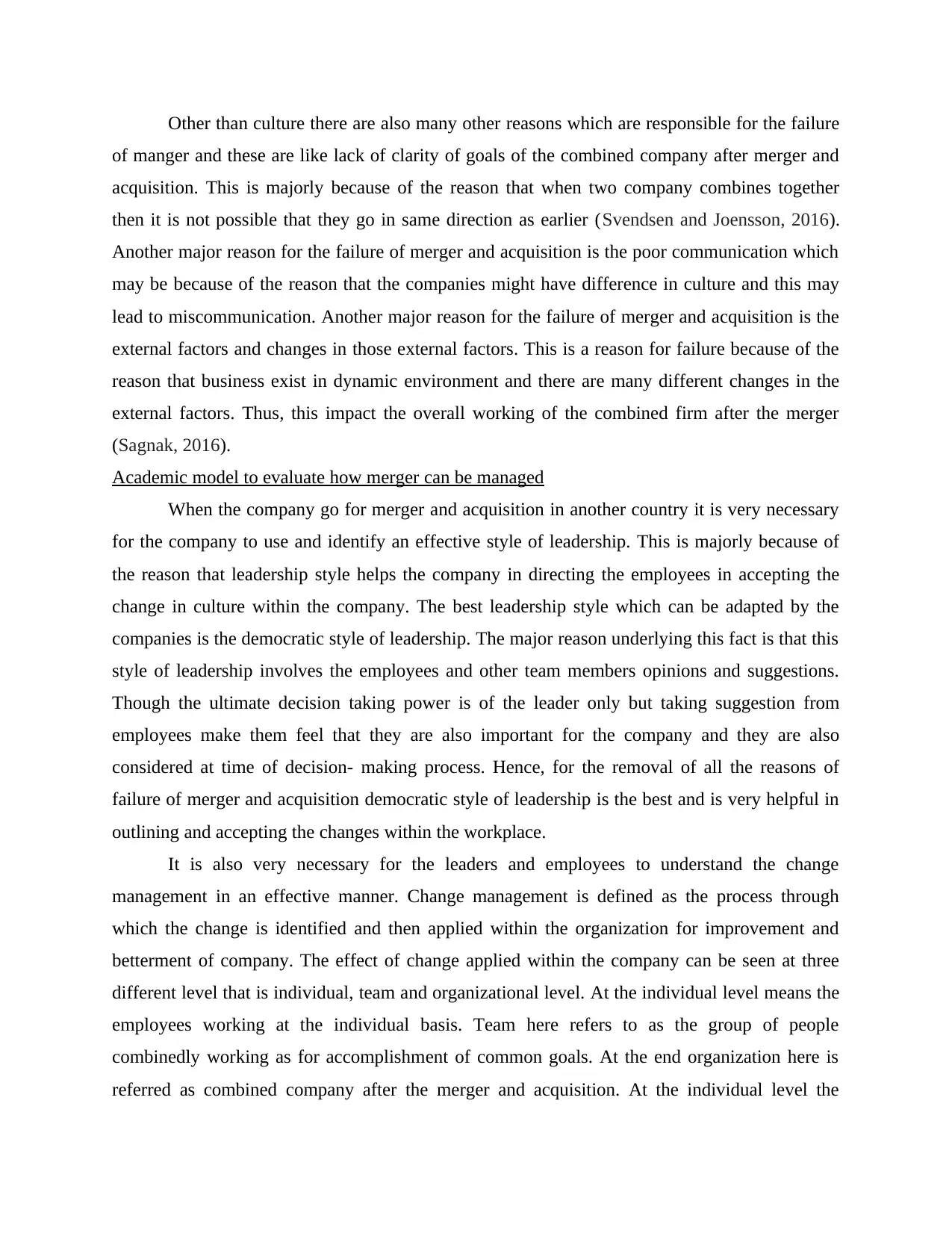
Other than culture there are also many other reasons which are responsible for the failure
of manger and these are like lack of clarity of goals of the combined company after merger and
acquisition. This is majorly because of the reason that when two company combines together
then it is not possible that they go in same direction as earlier (Svendsen and Joensson, 2016).
Another major reason for the failure of merger and acquisition is the poor communication which
may be because of the reason that the companies might have difference in culture and this may
lead to miscommunication. Another major reason for the failure of merger and acquisition is the
external factors and changes in those external factors. This is a reason for failure because of the
reason that business exist in dynamic environment and there are many different changes in the
external factors. Thus, this impact the overall working of the combined firm after the merger
(Sagnak, 2016).
Academic model to evaluate how merger can be managed
When the company go for merger and acquisition in another country it is very necessary
for the company to use and identify an effective style of leadership. This is majorly because of
the reason that leadership style helps the company in directing the employees in accepting the
change in culture within the company. The best leadership style which can be adapted by the
companies is the democratic style of leadership. The major reason underlying this fact is that this
style of leadership involves the employees and other team members opinions and suggestions.
Though the ultimate decision taking power is of the leader only but taking suggestion from
employees make them feel that they are also important for the company and they are also
considered at time of decision- making process. Hence, for the removal of all the reasons of
failure of merger and acquisition democratic style of leadership is the best and is very helpful in
outlining and accepting the changes within the workplace.
It is also very necessary for the leaders and employees to understand the change
management in an effective manner. Change management is defined as the process through
which the change is identified and then applied within the organization for improvement and
betterment of company. The effect of change applied within the company can be seen at three
different level that is individual, team and organizational level. At the individual level means the
employees working at the individual basis. Team here refers to as the group of people
combinedly working as for accomplishment of common goals. At the end organization here is
referred as combined company after the merger and acquisition. At the individual level the
of manger and these are like lack of clarity of goals of the combined company after merger and
acquisition. This is majorly because of the reason that when two company combines together
then it is not possible that they go in same direction as earlier (Svendsen and Joensson, 2016).
Another major reason for the failure of merger and acquisition is the poor communication which
may be because of the reason that the companies might have difference in culture and this may
lead to miscommunication. Another major reason for the failure of merger and acquisition is the
external factors and changes in those external factors. This is a reason for failure because of the
reason that business exist in dynamic environment and there are many different changes in the
external factors. Thus, this impact the overall working of the combined firm after the merger
(Sagnak, 2016).
Academic model to evaluate how merger can be managed
When the company go for merger and acquisition in another country it is very necessary
for the company to use and identify an effective style of leadership. This is majorly because of
the reason that leadership style helps the company in directing the employees in accepting the
change in culture within the company. The best leadership style which can be adapted by the
companies is the democratic style of leadership. The major reason underlying this fact is that this
style of leadership involves the employees and other team members opinions and suggestions.
Though the ultimate decision taking power is of the leader only but taking suggestion from
employees make them feel that they are also important for the company and they are also
considered at time of decision- making process. Hence, for the removal of all the reasons of
failure of merger and acquisition democratic style of leadership is the best and is very helpful in
outlining and accepting the changes within the workplace.
It is also very necessary for the leaders and employees to understand the change
management in an effective manner. Change management is defined as the process through
which the change is identified and then applied within the organization for improvement and
betterment of company. The effect of change applied within the company can be seen at three
different level that is individual, team and organizational level. At the individual level means the
employees working at the individual basis. Team here refers to as the group of people
combinedly working as for accomplishment of common goals. At the end organization here is
referred as combined company after the merger and acquisition. At the individual level the
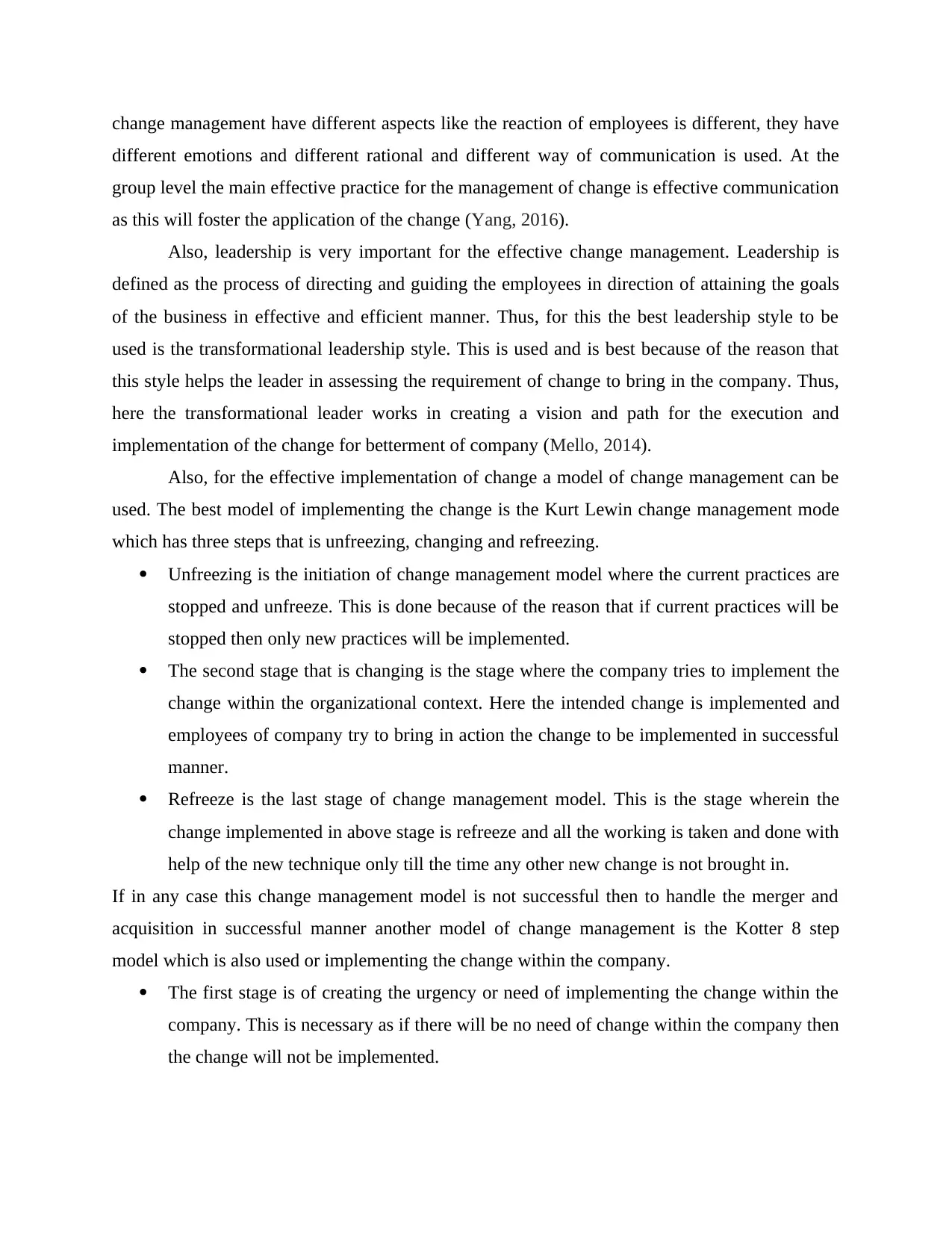
change management have different aspects like the reaction of employees is different, they have
different emotions and different rational and different way of communication is used. At the
group level the main effective practice for the management of change is effective communication
as this will foster the application of the change (Yang, 2016).
Also, leadership is very important for the effective change management. Leadership is
defined as the process of directing and guiding the employees in direction of attaining the goals
of the business in effective and efficient manner. Thus, for this the best leadership style to be
used is the transformational leadership style. This is used and is best because of the reason that
this style helps the leader in assessing the requirement of change to bring in the company. Thus,
here the transformational leader works in creating a vision and path for the execution and
implementation of the change for betterment of company (Mello, 2014).
Also, for the effective implementation of change a model of change management can be
used. The best model of implementing the change is the Kurt Lewin change management mode
which has three steps that is unfreezing, changing and refreezing.
Unfreezing is the initiation of change management model where the current practices are
stopped and unfreeze. This is done because of the reason that if current practices will be
stopped then only new practices will be implemented.
The second stage that is changing is the stage where the company tries to implement the
change within the organizational context. Here the intended change is implemented and
employees of company try to bring in action the change to be implemented in successful
manner.
Refreeze is the last stage of change management model. This is the stage wherein the
change implemented in above stage is refreeze and all the working is taken and done with
help of the new technique only till the time any other new change is not brought in.
If in any case this change management model is not successful then to handle the merger and
acquisition in successful manner another model of change management is the Kotter 8 step
model which is also used or implementing the change within the company.
The first stage is of creating the urgency or need of implementing the change within the
company. This is necessary as if there will be no need of change within the company then
the change will not be implemented.
different emotions and different rational and different way of communication is used. At the
group level the main effective practice for the management of change is effective communication
as this will foster the application of the change (Yang, 2016).
Also, leadership is very important for the effective change management. Leadership is
defined as the process of directing and guiding the employees in direction of attaining the goals
of the business in effective and efficient manner. Thus, for this the best leadership style to be
used is the transformational leadership style. This is used and is best because of the reason that
this style helps the leader in assessing the requirement of change to bring in the company. Thus,
here the transformational leader works in creating a vision and path for the execution and
implementation of the change for betterment of company (Mello, 2014).
Also, for the effective implementation of change a model of change management can be
used. The best model of implementing the change is the Kurt Lewin change management mode
which has three steps that is unfreezing, changing and refreezing.
Unfreezing is the initiation of change management model where the current practices are
stopped and unfreeze. This is done because of the reason that if current practices will be
stopped then only new practices will be implemented.
The second stage that is changing is the stage where the company tries to implement the
change within the organizational context. Here the intended change is implemented and
employees of company try to bring in action the change to be implemented in successful
manner.
Refreeze is the last stage of change management model. This is the stage wherein the
change implemented in above stage is refreeze and all the working is taken and done with
help of the new technique only till the time any other new change is not brought in.
If in any case this change management model is not successful then to handle the merger and
acquisition in successful manner another model of change management is the Kotter 8 step
model which is also used or implementing the change within the company.
The first stage is of creating the urgency or need of implementing the change within the
company. This is necessary as if there will be no need of change within the company then
the change will not be implemented.
⊘ This is a preview!⊘
Do you want full access?
Subscribe today to unlock all pages.

Trusted by 1+ million students worldwide
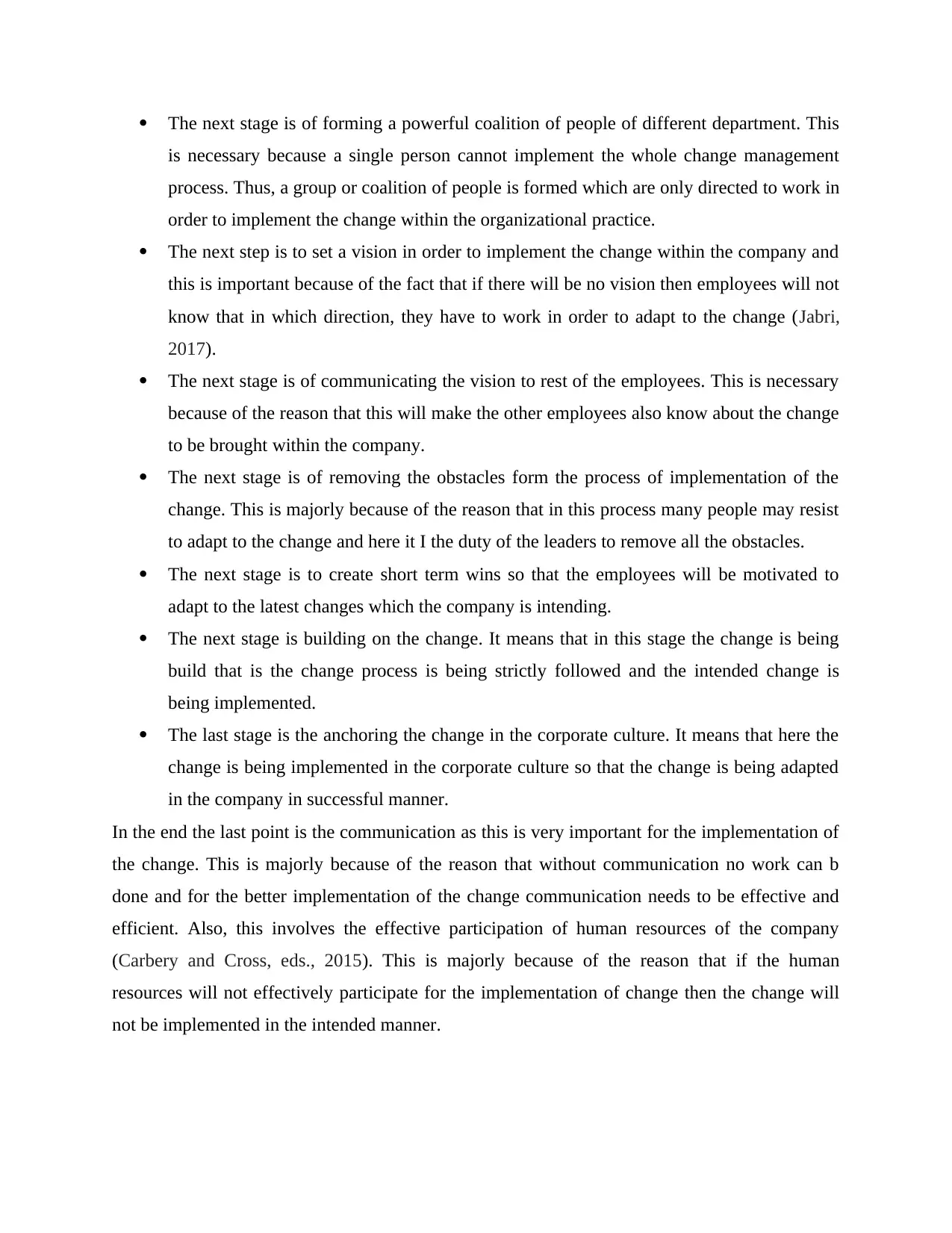
The next stage is of forming a powerful coalition of people of different department. This
is necessary because a single person cannot implement the whole change management
process. Thus, a group or coalition of people is formed which are only directed to work in
order to implement the change within the organizational practice.
The next step is to set a vision in order to implement the change within the company and
this is important because of the fact that if there will be no vision then employees will not
know that in which direction, they have to work in order to adapt to the change (Jabri,
2017).
The next stage is of communicating the vision to rest of the employees. This is necessary
because of the reason that this will make the other employees also know about the change
to be brought within the company.
The next stage is of removing the obstacles form the process of implementation of the
change. This is majorly because of the reason that in this process many people may resist
to adapt to the change and here it I the duty of the leaders to remove all the obstacles.
The next stage is to create short term wins so that the employees will be motivated to
adapt to the latest changes which the company is intending.
The next stage is building on the change. It means that in this stage the change is being
build that is the change process is being strictly followed and the intended change is
being implemented.
The last stage is the anchoring the change in the corporate culture. It means that here the
change is being implemented in the corporate culture so that the change is being adapted
in the company in successful manner.
In the end the last point is the communication as this is very important for the implementation of
the change. This is majorly because of the reason that without communication no work can b
done and for the better implementation of the change communication needs to be effective and
efficient. Also, this involves the effective participation of human resources of the company
(Carbery and Cross, eds., 2015). This is majorly because of the reason that if the human
resources will not effectively participate for the implementation of change then the change will
not be implemented in the intended manner.
is necessary because a single person cannot implement the whole change management
process. Thus, a group or coalition of people is formed which are only directed to work in
order to implement the change within the organizational practice.
The next step is to set a vision in order to implement the change within the company and
this is important because of the fact that if there will be no vision then employees will not
know that in which direction, they have to work in order to adapt to the change (Jabri,
2017).
The next stage is of communicating the vision to rest of the employees. This is necessary
because of the reason that this will make the other employees also know about the change
to be brought within the company.
The next stage is of removing the obstacles form the process of implementation of the
change. This is majorly because of the reason that in this process many people may resist
to adapt to the change and here it I the duty of the leaders to remove all the obstacles.
The next stage is to create short term wins so that the employees will be motivated to
adapt to the latest changes which the company is intending.
The next stage is building on the change. It means that in this stage the change is being
build that is the change process is being strictly followed and the intended change is
being implemented.
The last stage is the anchoring the change in the corporate culture. It means that here the
change is being implemented in the corporate culture so that the change is being adapted
in the company in successful manner.
In the end the last point is the communication as this is very important for the implementation of
the change. This is majorly because of the reason that without communication no work can b
done and for the better implementation of the change communication needs to be effective and
efficient. Also, this involves the effective participation of human resources of the company
(Carbery and Cross, eds., 2015). This is majorly because of the reason that if the human
resources will not effectively participate for the implementation of change then the change will
not be implemented in the intended manner.
Paraphrase This Document
Need a fresh take? Get an instant paraphrase of this document with our AI Paraphraser
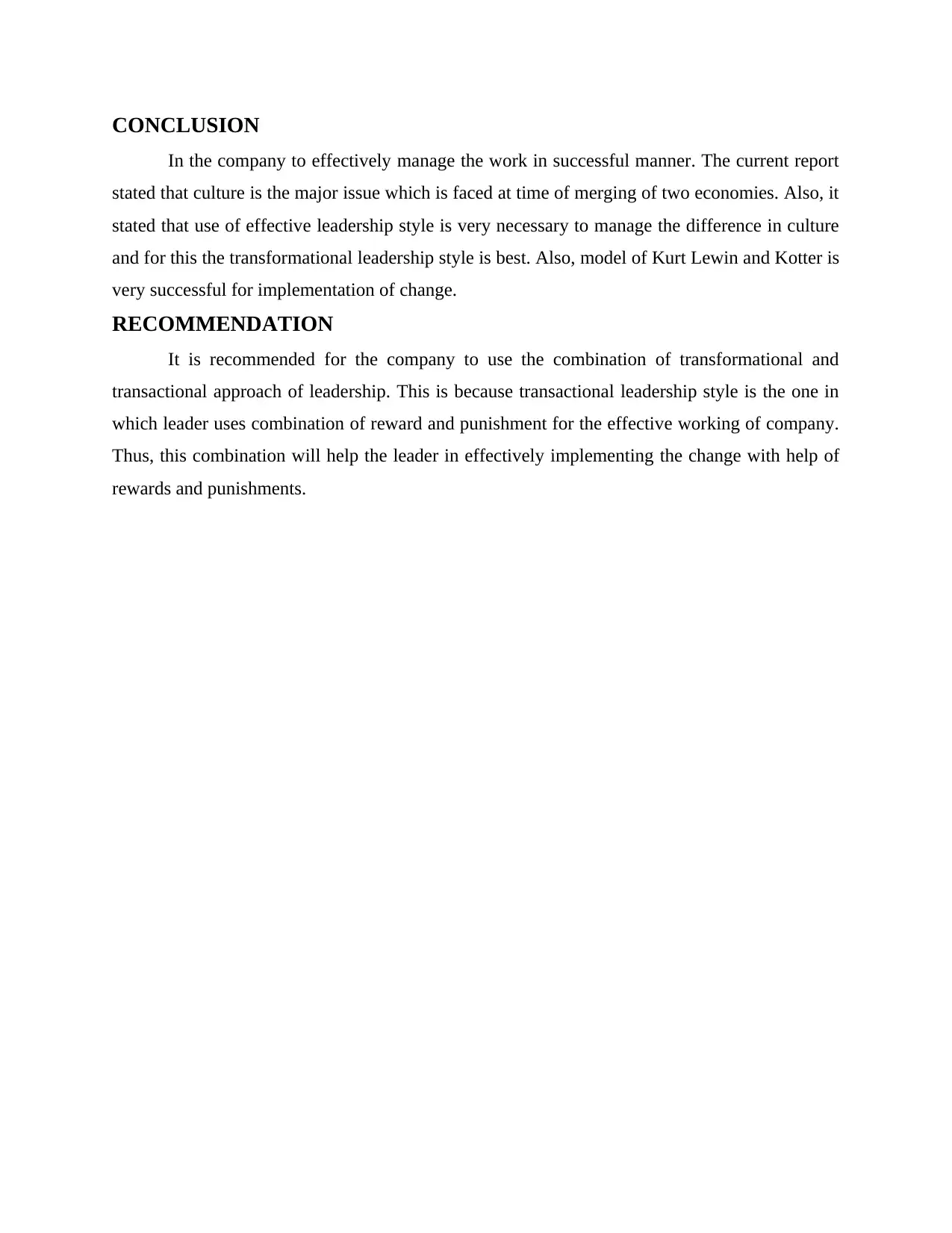
CONCLUSION
In the company to effectively manage the work in successful manner. The current report
stated that culture is the major issue which is faced at time of merging of two economies. Also, it
stated that use of effective leadership style is very necessary to manage the difference in culture
and for this the transformational leadership style is best. Also, model of Kurt Lewin and Kotter is
very successful for implementation of change.
RECOMMENDATION
It is recommended for the company to use the combination of transformational and
transactional approach of leadership. This is because transactional leadership style is the one in
which leader uses combination of reward and punishment for the effective working of company.
Thus, this combination will help the leader in effectively implementing the change with help of
rewards and punishments.
In the company to effectively manage the work in successful manner. The current report
stated that culture is the major issue which is faced at time of merging of two economies. Also, it
stated that use of effective leadership style is very necessary to manage the difference in culture
and for this the transformational leadership style is best. Also, model of Kurt Lewin and Kotter is
very successful for implementation of change.
RECOMMENDATION
It is recommended for the company to use the combination of transformational and
transactional approach of leadership. This is because transactional leadership style is the one in
which leader uses combination of reward and punishment for the effective working of company.
Thus, this combination will help the leader in effectively implementing the change with help of
rewards and punishments.
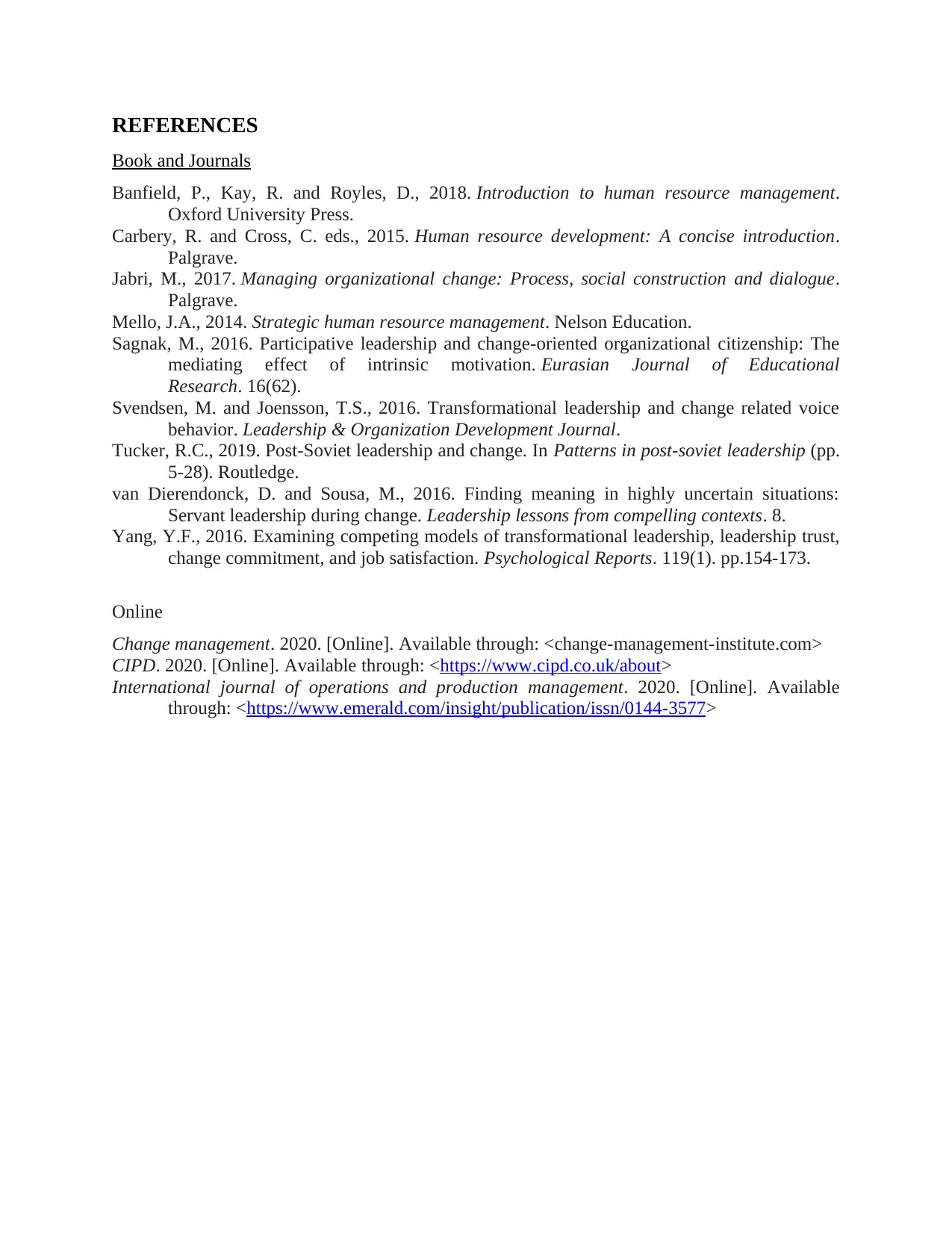
REFERENCES
Book and Journals
Banfield, P., Kay, R. and Royles, D., 2018. Introduction to human resource management.
Oxford University Press.
Carbery, R. and Cross, C. eds., 2015. Human resource development: A concise introduction.
Palgrave.
Jabri, M., 2017. Managing organizational change: Process, social construction and dialogue.
Palgrave.
Mello, J.A., 2014. Strategic human resource management. Nelson Education.
Sagnak, M., 2016. Participative leadership and change-oriented organizational citizenship: The
mediating effect of intrinsic motivation. Eurasian Journal of Educational
Research. 16(62).
Svendsen, M. and Joensson, T.S., 2016. Transformational leadership and change related voice
behavior. Leadership & Organization Development Journal.
Tucker, R.C., 2019. Post-Soviet leadership and change. In Patterns in post-soviet leadership (pp.
5-28). Routledge.
van Dierendonck, D. and Sousa, M., 2016. Finding meaning in highly uncertain situations:
Servant leadership during change. Leadership lessons from compelling contexts. 8.
Yang, Y.F., 2016. Examining competing models of transformational leadership, leadership trust,
change commitment, and job satisfaction. Psychological Reports. 119(1). pp.154-173.
Online
Change management. 2020. [Online]. Available through: <change-management-institute.com>
CIPD. 2020. [Online]. Available through: <https://www.cipd.co.uk/about>
International journal of operations and production management. 2020. [Online]. Available
through: <https://www.emerald.com/insight/publication/issn/0144-3577>
Book and Journals
Banfield, P., Kay, R. and Royles, D., 2018. Introduction to human resource management.
Oxford University Press.
Carbery, R. and Cross, C. eds., 2015. Human resource development: A concise introduction.
Palgrave.
Jabri, M., 2017. Managing organizational change: Process, social construction and dialogue.
Palgrave.
Mello, J.A., 2014. Strategic human resource management. Nelson Education.
Sagnak, M., 2016. Participative leadership and change-oriented organizational citizenship: The
mediating effect of intrinsic motivation. Eurasian Journal of Educational
Research. 16(62).
Svendsen, M. and Joensson, T.S., 2016. Transformational leadership and change related voice
behavior. Leadership & Organization Development Journal.
Tucker, R.C., 2019. Post-Soviet leadership and change. In Patterns in post-soviet leadership (pp.
5-28). Routledge.
van Dierendonck, D. and Sousa, M., 2016. Finding meaning in highly uncertain situations:
Servant leadership during change. Leadership lessons from compelling contexts. 8.
Yang, Y.F., 2016. Examining competing models of transformational leadership, leadership trust,
change commitment, and job satisfaction. Psychological Reports. 119(1). pp.154-173.
Online
Change management. 2020. [Online]. Available through: <change-management-institute.com>
CIPD. 2020. [Online]. Available through: <https://www.cipd.co.uk/about>
International journal of operations and production management. 2020. [Online]. Available
through: <https://www.emerald.com/insight/publication/issn/0144-3577>
⊘ This is a preview!⊘
Do you want full access?
Subscribe today to unlock all pages.

Trusted by 1+ million students worldwide
1 out of 13
Related Documents
Your All-in-One AI-Powered Toolkit for Academic Success.
+13062052269
info@desklib.com
Available 24*7 on WhatsApp / Email
![[object Object]](/_next/static/media/star-bottom.7253800d.svg)
Unlock your academic potential
Copyright © 2020–2025 A2Z Services. All Rights Reserved. Developed and managed by ZUCOL.





